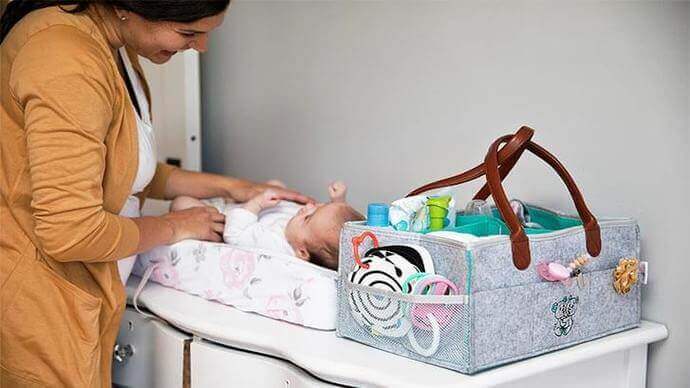As a new mom, you’re bound to be on the lookout for any signs of discomfort or distress in your little one. Colic pain and gas pain are two common issues that many babies experience in their early months, but they can be difficult to tell apart.
Understanding the difference between these two types of pain is crucial for providing your baby with the proper care and relief they need.
Table of Contents
Understanding Colic Pain vs Gas Pain in Babies
In this article, we’ll take a closer look at what colic pain and gas pain are, how to differentiate between the two, and the various causes, risk factors, and treatments available.
We’ll also provide some practical tips for preventing colic and gas pain in babies, as well as how to cope with the emotional and physical toll it may take on parents.
So, whether you’re a first-time mom or have been through this before, read on to gain a better understanding of colic pain and gas pain in babies.

What is Colic Pain?
Colic pain is a type of pain that occurs in babies and is characterized by excessive crying and fussiness. While the exact cause of colic pain is unknown, it is generally believed to be related to the digestive system.
Colic pain can begin as early as two weeks after birth and typically peaks around six weeks of age, with most babies outgrowing it by three to four months.
Common signs and symptoms of colic pain include:
- Intense crying for no apparent reason, often in the late afternoon or evening
- Clenched fists, arched back, and tensed abdominal muscles
- Difficulty sleeping or staying asleep
Refusing to eat or eating more frequently than usual
What is Gas Pain?
Gas pain, on the other hand, is caused by the buildup of gas in the intestines. This can result in discomfort, bloating, and fussiness in babies.
Gas pain can occur at any time, but it is more common during the first few months of life when a baby’s digestive system is still developing.
Common signs and symptoms of gas pain include:
- Crying or fussiness during or after feeding
- Pulling legs up to the chest or arching the back
- Passing gas frequently or having difficulty passing gas
- Refusing to eat or eating more slowly than usual
The Differences Between Colic Pain and Gas Pain
While colic pain and gas pain may share some similar symptoms, there are key differences between the two. Colic pain is generally characterized by intense crying and fussiness, while gas pain is more often associated with discomfort and bloating.
Colic pain also tends to occur at a specific time of day, while gas pain can occur at any time. To differentiate between the two, pay attention to when your baby is experiencing discomfort and what other symptoms they are exhibiting.
| Colic Pain | Gas Pain | |
| Definition | Prolonged, unexplained crying in babies | Pain caused by gas in the digestive tract of babies |
| Symptoms | Intense crying, arching back, clenched fists | Crying, squirming, pulling legs to the belly, bloating |
| Timing | Often in the late afternoon or evening | Can occur anytime after feeding |
| Causes | Unknown | Swallowed air during feeding, improper feeding |
| Treatment | Swaddling, rocking, white noise, probiotics | Burping, tummy massage, bicycling legs, simethicone |
| Prevention tips | Smaller, more frequent feedings | Burping frequently during feeding |
Causes of Colic Pain and Gas Pain in Babies
The causes of colic pain and gas pain in babies are not fully understood, but there are several factors that may contribute to their development. These include genetics, feeding habits, and environmental factors such as stress or exposure to cigarette smoke.
Breastfed babies may be less likely to experience colic pain and gas pain, as breast milk is easier to digest than formula. However, some babies may be sensitive to certain foods in their mother’s diet, which can contribute to colic and gas pain. In formula-fed babies, a switch to a different formula may be necessary to alleviate symptoms.
Risk Factors for Colic and Gas Pain in Babies
While any baby can experience colic and gas pain, there are certain risk factors that may increase the likelihood of these issues. These include premature birth, a family history of colic, and a difficult labor or delivery.
Additionally, babies who are formula-fed or have a sensitivity to certain foods may be at a higher risk for colic and gas pain. If your baby is at a higher risk for colic and gas pain, it’s important to be vigilant for any signs of discomfort and to take steps to prevent and alleviate symptoms as necessary
Diagnosis and Treatment of Colic Pain and Gas Pain
Diagnosing colic pain and gas pain in babies can be challenging, as there is no specific test or exam that can definitively diagnose these issues.
Instead, diagnosis is based on the presence of specific symptoms. If you suspect that your baby is experiencing colic pain or gas pain, there are several treatment options available to help alleviate their discomfort. These can include over-the-counter remedies such as gas drops or anti-reflux medication, as well as home remedies like gentle tummy massages or warm baths.
It’s important to talk to your pediatrician before trying any new treatments or remedies, as they can provide guidance on the best course of action for your baby’s specific needs.
Preventing Colic Pain and Gas Pain in Babies
While it’s not always possible to prevent colic pain and gas pain in babies, there are steps you can take to minimize the likelihood of these issues occurring.
This can include establishing a consistent feeding routine, burping your baby regularly during and after feedings, and creating a calm and soothing environment for your baby. To help relieve colic and gas pain in babies, parents can try different techniques such as the newborn burping technique to release any trapped air in the baby’s stomach.
It is also essential to ensure proper feeding habits and consider using the best baby bottle for gas or colic prevention. Breastfeeding mothers may also want to consider eliminating certain foods from their diet that may be contributing to their baby’s discomfort.
Additionally, it’s important to limit your baby’s exposure to potential irritants such as cigarette smoke or overly stimulating environments.
Coping with Colic Pain and Gas Pain as a Parent
Dealing with colic pain and gas pain in a baby can be incredibly stressful and overwhelming for parents.
It’s important to remember that these issues are common and that there are resources available to help you cope with the emotional and physical toll they may take. One effective coping strategy is to establish a support system of family and friends who can provide assistance and emotional support when needed.
It’s also important to take care of yourself by getting enough rest, eating well, and engaging in activities that help you relax and unwind. If you find that you are struggling to cope with the stress and anxiety of colic pain and gas pain, don’t hesitate to reach out to a mental health professional or support group for additional help and guidance.
When to Seek Medical Attention for Colic Pain and Gas Pain
While colic pain and gas pain are common issues in babies, there are times when medical attention may be necessary.
If your baby’s symptoms are severe or persistent, or if they are exhibiting other signs of illness such as fever or vomiting, it’s important to seek medical attention right away. Additionally, if you have concerns about your baby’s growth or development, or if you are unsure about how to properly care for your baby, don’t hesitate to reach out to your pediatrician for guidance and support.
While colic pain and gas pain are common issues in babies, there are times when medical attention may be necessary.
If your baby’s symptoms are severe or persistent, or if they are exhibiting other signs of illness such as fever or vomiting, it’s important to seek medical attention right away. Additionally, if you have concerns about your baby’s growth or development, or if you are unsure about how to properly care for your baby, don’t hesitate to reach out to your pediatrician for guidance and support.
FAQ for Colic and Gas Pains
What is the 3 3 3 rule for colic?
The 3 3 3 rule for colic involves the following:
The baby cries for more than three hours a day
The crying occurs at least three days a week
The crying persists for at least three weeks
If a baby meets these criteria, it may be diagnosed with colic. However, it is important to note that there is no specific treatment for colic and that the condition usually resolves on its own within a few months.
What are the peak hours for colic?
There are no specific peak hours for colic. It can occur at any time of the day or night, but it is more common in the late afternoon and evening.
How can breastfeeding mothers prevent colic pain and gas pain in babies?
Breastfeeding mothers may want to consider eliminating certain foods from their diet that may be contributing to their baby’s discomfort like dairy products, caffeine, spicy foods, and gas-producing vegetables namely broccoli and cauliflower. Additionally, some babies may be sensitive to certain proteins found in foods like soy, wheat, and nuts, so it’s important to talk to your doctor if you suspect that your baby may have food sensitivity. It’s also important to establish a consistent feeding routine and ensure that your baby is properly latched and positioned during feedings.
What are some risk factors for colic and gas pain in babies?
Premature birth, a family history of colic, and difficult labor or delivery are some risk factors for colic and gas pain in babies. Additionally, babies who are formula-fed or have a sensitivity to certain foods may be at a higher risk for colic and gas pain.
What are some coping strategies for parents dealing with colic pain and gas pain in babies?
Establishing a support system of family and friends who can provide assistance and emotional support when needed can be an effective coping strategy. It’s also important to take care of yourself by getting enough rest, eating well, and engaging in activities that help you relax and unwind.
Summary
Understanding the difference between colic pain and gas pain in babies is crucial for providing your little one with the proper care and relief they need.
By being aware of the signs and symptoms of these issues, as well as the various causes, risk factors, and treatment options available, you can help your baby feel more comfortable and content. Remember, dealing with colic pain and gas pain in a baby can be challenging, but it’s important to stay patient, stay informed, and seek out support when needed.
With the right care and attention, you and your baby can get through this difficult time and enjoy all the joys that come with parenthood.




